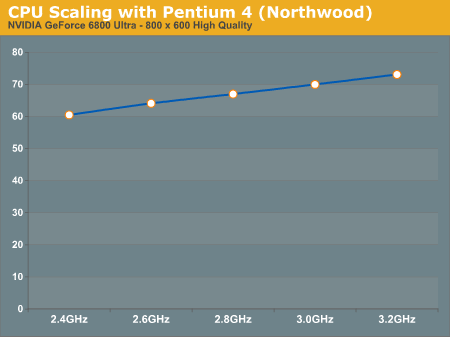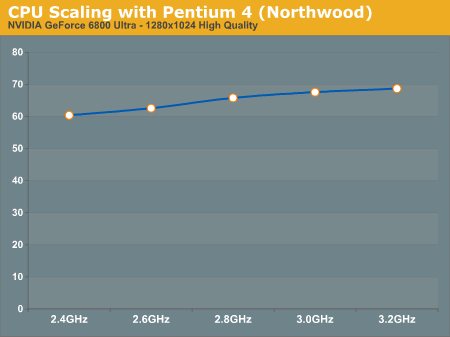How does CPU Speed Impact Graphics Performance?
For the most part, we ultimately make our purchasing decisions based on price. If we have $200 to spend on a processor, it doesn't matter how fast an Extreme Edition runs our apps and games unless it sells for $200. It's the price point that determines what our options are, and then we look at the best performer at that price point to make our final decision. But when upgrading, it's sometimes difficult to know when to upgrade various components - especially a CPU.
If you have a 2.4GHz Pentium 4, is it worth it to upgrade to a 3.4GHz P4 in order to get greater performance in Doom 3? Or is your 2.4GHz P4 paired up just fine with a NVIDIA 6800GT? These next set of graphs are designed to help you see the type of CPU scaling you can expect out of a high end card like the GeForce 6800 Ultra, or a slower card like the Radeon 9800 Pro.
The graphs below are frame rate vs. clock speed graphs, taken using a Pentium 4 C and varying the clock speed on a single platform. Once again it's the curve of the graph that you want to look at; the steeper the slope of the curve is, the more benefit you'll get from having a faster CPU. The flatter the curve is, the less benefit you'll get from having a faster CPU.
Although we're only showing two cards here, you can extrapolate performance of faster and/or slower cards pretty easily. Using our Doom 3 Graphics Guide you should know what cards are faster or slower than the two we're representing here; then just remember that a faster card will have a steeper (more CPU dependent) curve, while a slower card will have a flatter (less CPU dependent curve).
Also keep in mind that the scaling will be relatively similar for both AMD and Intel platforms; we chose to stick with only a single platform here in the interest of time as well as keeping these pages simple.
First up, we have the 6800 Ultra at 800x600:

Here we have a decently steep curve, probably the steepest it will get since we're dealing with one of the fastest GPUs at a relatively low resolution. The move from a 2.4GHz to a 3.2GHz processor resulted in a 21% increase in performance, considering that this was because of a 33% increase in clock speed it is safe to say that at lower resolutions the more money you put into a faster CPU, the higher your Doom 3 performance will be on a 6800 Ultra.

At higher resolutions the burden shifts to the GPU as is evident by the change in the slope of the curve. Now we have a distinctly more flat curve, with only a 13% difference between the fastest and the slowest CPUs - it's not insignificant, but definitely not huge.

Looking at the 9800 Pro at 800x600 we see a curve that closely resembles the 6800 Ultra's curve at 1280x1024, once again with a 13% gain seen from the 2.4GHz processor to the 3.2GHz part.
Although the rest of our CPU tests use the 6800 Ultra, the standings and degrees of performance improvement will apply to other graphics cards as well. As we've just seen, at 1280x1024 the GeForce 6800 Ultra scales much like a Radeon 9800 Pro at 800x600 - keep that in mind as we compare CPUs under id's latest and most impressive 3D game to date.










59 Comments
View All Comments
Anemone - Thursday, August 5, 2004 - link
I suggest you look at the low and average framerates for the EE @ 1600x1200. From memory I recall on HardOCP was that the AMD chips had a higher top end and a lower low end, making the average, whereas the P4's had high and low ends not so far away from their average.AMD64's fly, but at higher res's 1280 up to 1600, the difference is a few fps, and P4's seem to not fly as fast, but also not bottom out as bad in the super heavy scenes.
While I'm torn on the issue of which platform to go to, that is something I noticed.
DigitalDivine - Thursday, August 5, 2004 - link
Shinei, hardocp did not use apples to apples comparisons.dmxlite - Thursday, August 5, 2004 - link
"When tested at 1600 and real gameplay, Athlon 64 falls like a brick, as shown in the "Official Doom 3 hardware guide" at HardOCP."Yes, that must be the reason why in the conclusion they say "AMD came out ahead in DOOM 3 performance with the strongest CPU in our tests, the Athlon 64 FX-53 processor," and why they chose the stock FX to be in their [H]ard|OCP Ultimate DOOM 3 System and an overclocked A64 3000+ to be in their [H]ard|OCP Ultimate Enthusiast DOOM 3 System.
nlr_2000 - Wednesday, August 4, 2004 - link
It's called an on die memory controller ;)Staples - Wednesday, August 4, 2004 - link
Interesting how P4s were always top dog in Q3 but now with D3, it is the opposite.Shinei - Wednesday, August 4, 2004 - link
I don't know about you, T8000, but I can't complain about my (underclocked) 64MB Ti4200 and 3200+ XP combination. It drags in some areas (9fps as a low, 60 as a high, average gameplay flow is around 20; settings are 10x7 medium quality), but it's definitely playable in singleplayer, with very little mouse lag.So, for my Athlon XP to be performing fairly well with 2-year-old, underclocked hardware, I'm willing to say that HOCP is probably making things retarded for AMD by changing settings or something. I find it very hard to believe that the vastly superior Athlon 64s (compared to my Athlon XP) would falter so heavily in gameplay when my own processor does not.
T8000 - Wednesday, August 4, 2004 - link
I think you cannot say a CPU is better because it produces more frames in situations where it is hardly stressed, like lower resolutions and timedemos. Furthermore, I think most people want to play at an acceptable framerate with as much detail as possible, so testing a GF6800U only at 1280 and without playing the game, is not realistic.When tested at 1600 and real gameplay, Athlon 64 falls like a brick, as shown in the "Official Doom 3 hardware guide" at HardOCP. Only the overclocked Athlon FX could do slightly more then the P4EE at stock settings.
flexy - Wednesday, August 4, 2004 - link
>>>Whether the top-performing FX53 is worth the $811 price is up to you,
>>>
The answer is of course: NO
Neither is the PIV EE worth its price :)
flexy - Wednesday, August 4, 2004 - link
the most important info for me is that it's actually nonsense to wait for socket 939...or useless to spend more money for 1mb cache.So...socket 754 is even better/faster and cheaper. And the 512kb cache are plenty too for the A64.
This is very helpful info in regards to upgrading my system soon :)
Pumpkinierre - Wednesday, August 4, 2004 - link
Nice article Anand- strange set of results. I'd like to see the benchmark for a 2.4c at 3200MHz with same memory latency settings. If it is memory latency as the a64 results suggest then the Prescott should be lower or even beaten by N'wood. If it is L1 cache size then the EE result should be lower.